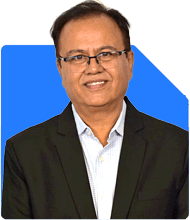Hi Sir, I'm 31 years old and having a monthly take home around 1 Lakh , I have FD of 6 Lakh, PPF of 2.50 L, NPS of 1 Lakh and Mutual Fund of 8 Lakh ( 2 Flexi Fund, 2 Mid Cap Fund, 2 Small Cap, 1 BAF and 1 ELSS) with monthly SIP 55000. I have no loan. I have only two major goals as of now as I don't have any kid:
Goal 1. Need to generate a corpus of 1 Cr. In next 5 year to buy a house , will this be possible with this SIP Plan?
Goal 2- I need to retire by age 50 with 10 Crores of corpus at present value. Will my SIP suffice if not then by what % I need to increase it YoY if I don't wanna increase the SIP value?
Please help me with your invaluable advice :)
Ans: Creating a robust financial plan to achieve your goals of buying a house and retiring early is essential. At 31 years old with a strong monthly income and substantial investments, you are well-positioned to reach your financial objectives. Let's analyze your current financial situation and strategize to meet your goals of buying a house worth Rs. 1 crore in the next five years and retiring by 50 with a corpus of Rs. 10 crores.
Evaluating Your Current Financial Situation
Income and Investments
Your monthly take-home salary is Rs. 1 lakh. Here's a breakdown of your current investments:
Fixed Deposit (FD): Rs. 6 lakhs
Public Provident Fund (PPF): Rs. 2.5 lakhs
National Pension System (NPS): Rs. 1 lakh
Mutual Funds (MF): Rs. 8 lakhs across various funds
Monthly SIP: Rs. 55,000
Your disciplined investment approach is commendable and sets a solid foundation for achieving your financial goals.
Goal 1: Generating a Corpus of Rs. 1 Crore in 5 Years
Current SIP Analysis
To determine if your current SIP of Rs. 55,000 per month can help you achieve a corpus of Rs. 1 crore in five years, let's consider the potential growth of your investments. Assuming an average annual return of 12% on your mutual funds, the future value of your SIPs can be estimated.
With a consistent SIP of Rs. 55,000 per month, you are on track to achieve substantial growth. However, it's important to regularly review and adjust your investments based on market performance and your financial goals.
Additional Strategies
If your current SIP falls short of the Rs. 1 crore target, consider these strategies:
Increase SIP Contributions: If feasible, gradually increase your SIP contributions each year. A 10-15% annual increase can significantly boost your corpus.
Lump Sum Investments: Allocate a portion of your FD or other savings to a lump sum investment in equity mutual funds. This can provide higher returns compared to traditional savings instruments.
Review and Rebalance Portfolio: Ensure your portfolio is well-diversified and aligned with your risk tolerance and financial goals. Rebalance your portfolio periodically to optimize returns.
Goal 2: Retiring by Age 50 with a Corpus of Rs. 10 Crores
Assessing Your Retirement Goal
To retire by age 50 with a corpus of Rs. 10 crores, you need to ensure that your investments are growing at a healthy rate. Considering you have 19 years until you reach 50, let's evaluate if your current SIPs and investments are sufficient.
Calculating Required SIP Growth
Assuming an average annual return of 12% on your mutual funds, let's estimate the future value of your current SIPs and the additional contributions needed:
Current SIP of Rs. 55,000 per month:
Projected Future Value (FV) at 12% annual return over 19 years can be significant but may need a boost.
Increasing SIP Contributions Annually:
To avoid increasing the SIP value drastically, you can opt for a systematic increase of 10-15% per year. This approach leverages the power of compounding and incremental growth.
Additional Investments and Strategies
To bridge any gaps and ensure you meet your retirement goal, consider the following:
Utilize Annual Bonuses and Increments: Allocate any annual bonuses, increments, or windfalls towards your investment corpus.
Optimize Tax Savings: Maximize contributions to tax-saving instruments like PPF, NPS, and ELSS. This not only reduces your tax liability but also boosts your investment corpus.
Diversify Investments: Ensure a mix of equity and debt investments. Equity funds provide growth, while debt funds offer stability and risk mitigation.
Detailed Investment Plan and Strategies
Fixed Deposits (FD)
Your current FD of Rs. 6 lakhs is a safe but low-return investment. Consider reallocating a portion of this to higher-yield investments like mutual funds or direct equity. Retain some amount in FD for emergency liquidity.
Public Provident Fund (PPF)
PPF is a long-term investment with tax benefits. Continue your annual contributions to PPF, as it provides stable returns and tax-free maturity. Aim to maximize your yearly contribution limit to Rs. 1.5 lakhs.
National Pension System (NPS)
NPS is a good retirement savings tool. Continue your contributions to NPS, considering the tax benefits under Section 80C and 80CCD. You can increase your contributions periodically to enhance your retirement corpus.
Mutual Funds
Your current mutual fund portfolio is well-diversified across flexi, mid-cap, small-cap, BAF, and ELSS funds. Here's a detailed strategy to optimize your mutual fund investments:
Flexi Funds: Continue your investments in flexi funds as they provide flexibility to invest across market capitalizations, offering balanced risk and return.
Mid and Small Cap Funds: These funds have high growth potential but come with higher risk. Maintain a balanced allocation and review performance periodically.
Balanced Advantage Fund (BAF): BAFs provide a balanced approach with a mix of equity and debt. Continue your SIP in BAF for risk management and steady returns.
Equity-Linked Savings Scheme (ELSS): ELSS offers tax benefits under Section 80C and good returns. Continue your SIP in ELSS for tax-efficient growth.
Future Strategy and Incremental SIP Increase
To achieve your long-term goal of Rs. 10 crores by retirement, an annual incremental increase in SIPs is advisable. Assuming a 10-15% annual increase in SIPs, you can significantly enhance your investment corpus. Here's how:
Year 1: Rs. 55,000
Year 2: Rs. 60,500 (10% increase)
Year 3: Rs. 66,550 (10% increase)
Year 4: Rs. 73,205 (10% increase)
Year 5: Rs. 80,526 (10% increase)
By following this incremental approach, your SIP contributions will grow substantially, leveraging the power of compounding to reach your financial goals.
Risk Management and Contingency Planning
Emergency Fund
Ensure you have an adequate emergency fund to cover 6-12 months of living expenses. This fund should be easily accessible and kept in liquid assets like savings accounts or short-term FDs.
Insurance
Life Insurance: Adequate life insurance coverage is essential to protect your family’s financial future. Consider term insurance for high coverage at low premiums.
Health Insurance: Ensure you and your family have comprehensive health insurance coverage to safeguard against medical emergencies and expenses.
Tax Planning and Efficiency
Maximize Tax-saving Investments
Utilize the full benefits of Section 80C by contributing to PPF, ELSS, NPS, and other eligible investments. Efficient tax planning reduces your tax liability and increases your investable surplus.
Regular Review and Adjustments
Annual Portfolio Review
Conduct an annual review of your portfolio to assess performance and make necessary adjustments. This ensures your investments remain aligned with your goals and risk tolerance.
Rebalancing
Periodically rebalance your portfolio to maintain the desired asset allocation. This involves selling over-performing assets and reinvesting in underperforming ones to manage risk and optimize returns.
Professional Guidance
Certified Financial Planner (CFP)
Engaging a CFP can provide expert advice and tailored financial planning. A CFP helps you navigate complex financial decisions and stay on track to achieve your goals.
Final Insights
Achieving your financial goals of buying a house and retiring early requires disciplined planning and strategic investments. By increasing your SIP contributions, optimizing your portfolio, and leveraging tax-efficient investments, you can create substantial wealth.
Regularly review and adjust your financial plan to stay aligned with your goals. Engaging a Certified Financial Planner ensures professional guidance and support in your financial journey.
Your proactive approach to financial planning is commendable. With the right strategies and disciplined execution, you can achieve your goals and secure a prosperous future.
Best Regards,
K. Ramalingam, MBA, CFP,
Chief Financial Planner,
www.holisticinvestment.in
















.jpg)









